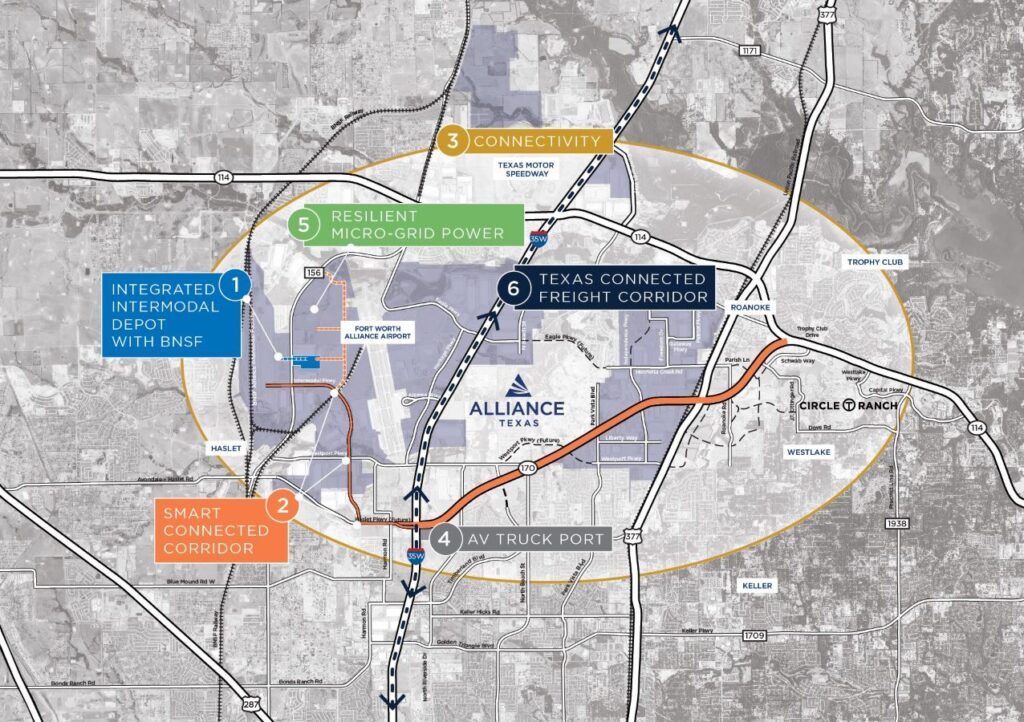In today’s interconnected and globalized world, supply chains are critical in ensuring the smooth flow of goods and services across regions and countries. However, various and often unexpected challenges have hindered the creation of a seamless supply chain model, leading to disruptions and inefficiencies that adversely affect economies and communities. To overcome these obstacles and build a resilient supply chain for the future, cities, and businesses need to embrace public-private partnerships while leveraging cutting-edge technology and infrastructure to create more intelligent supply chain innovations.
Visibility Improves Efficiency
The current supply chain system faces significant bottlenecks and challenges that impact its efficiency. On average, every 3.7 years, major supply chain disruptions occur. From conflict and trade disputes to natural disasters and cyberattacks, disruptions can take a month or more to correct. The impact creates delays and congestion that lingers, but a lack of real-time visibility is a major reason supply chain operations can’t rebound quickly. To achieve resilience in the supply chain means having the ability to withstand disruptions, no matter what unforeseen circumstances occur, and quickly recover while maintaining seamless operations.
The US spends $2 trillion on shipping costs annually–70% of which is attributed to transportation–but intermodal rail and autonomous technology have the upward potential to reduce cost and greenhouse emissions by over 65%. Autonomous technology specifically has the potential to reduce drayage costs by up to 70% compared to traditional models that heavily depend on human capital. To achieve resiliency and sustainability in the supply chain, embracing advanced technology and interconnectivity is crucial. Regional, state, and national leaders must have the ability to leverage real-time tracking capabilities to monitor goods and services from departure points to final destinations. This level of visibility not only facilitates proactive decision making, but also minimizes risks, and elevates overall supply chain performance. As the market and demand continue to evolve, the need for integrated communication and supply chain innovation has never been greater.
The Port of the Future
Smart Ports are more productive, sustainable transport hubs offering fully integrated logistics systems that monitor the entire journey of goods, identify challenges, optimize solutions in real time, and function as an information-sharing platform between a variety of logistic actors. But their impact goes beyond mere efficiency improvements to deliver more holistic, long-term insights that improve and converge both the physical and digital worlds to provide a better quality of life for the companies, communities, and people it serves.
The AllianceTexas Smart Port, a $250 million public-private partnership, emerges as a solution that empowers the North Texas supply chain to function efficiently even during emergencies. By leveraging integrated communication, technology, augmentable microgrid solutions, and calculated surface infrastructure, the AllianceTexas Smart Port offers a one-of-a-kind ecosystem, providing a 24/7 transportation model that supports continuous logistics movement without interruption. The AllianceTexas Smart Port is strategically connected to a network of North Texas-managed corridors utilizing technology lanes to dynamically manage freight pathways across the DFW metroplex. On a state and national level, it resides along the 865-mile Texas Connected Freight Corridors, including critical border-to-border corridors like I-35 and I-45, making it possible to seamlessly move millions of shipments and track goods between Canada and Mexico more efficiently and securely than ever before.
With supply chain innovations like the AllianceTexas Smart Port in place, North Texas can efficiently handle complex, large-scale distribution challenges posed by the ever-increasing demands of manufacturing and e-commerce fulfillment companies. The insight-driven technology also serves as a safeguard against future unpredictability, such as global pandemics, providing invaluable protection to businesses and communities to secure sustainability in the supply chain regionally and far beyond.
The Case for Smart Ports
The benefits of the AllianceTexas Smart Port extend to businesses, consumers and local communities. For businesses, the Smart Port is a game-changer. It minimizes supply chain interruptions and enhances logistics efficiency, allowing companies to optimize their operations and ensure seamless product movement. Moreover, the Smart Port fosters resiliency and sustainability in the supply chain, reducing the vulnerability of businesses to disruptions caused by external factors.
On the consumer side, implementing a Smart Port ensures safer, less congested transportation routes, resulting in faster delivery times and enhanced access to goods and services. Additionally, the real-time tracking capabilities facilitate the timely delivery of critical medicines, vaccines, and disaster relief supplies, addressing health and community needs with greater responsiveness. Local communities also experience the benefits of a Smart Port, which escalates economic development and investment while reducing traffic congestion and greenhouse gas emissions caused by alternatively powered vehicles, warehouses, and conscientious infrastructure.
AllianceTexas, with its existing transportation infrastructure, proves to be an ideal location for the Smart Port. Surrounded by over 70 million square feet of industrial Class A development, it offers a strategic thoroughfare for thousands of long-haul trucks daily, alongside accommodating the needs of two million area residents.
At the Gateway to a New Logistics Era
Attaining sustainable resilience in the supply chain begins with the seamless integration of technology and infrastructure. The AllianceTexas Smart Port sets a powerful example of how regional, state, and national leaders can work together to create a resilient supply chain model that scales not only the North Texas region but also has a far-reaching impact across the world. Embracing smart logistics hubs like the Smart Port is the path to a future where supply chains are robust, adaptable, and able to withstand any challenges that come their way. Investing in technology-driven solutions can pave the way for a truly resilient and efficient supply chain that benefits businesses, communities, and consumers alike.
